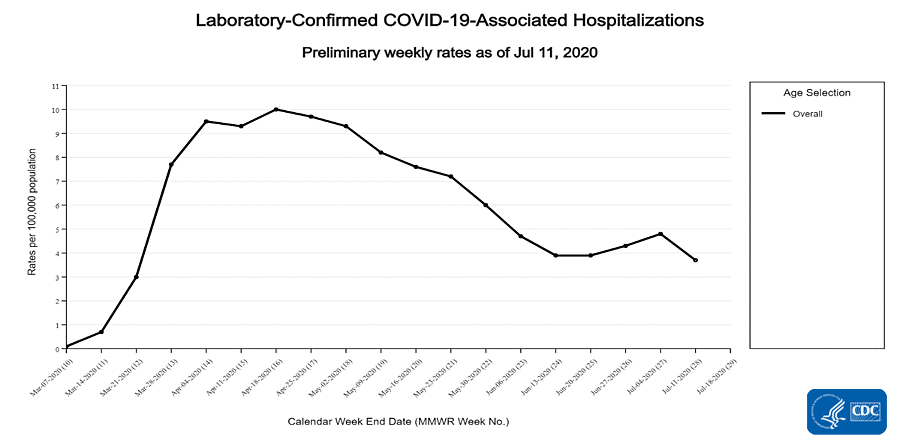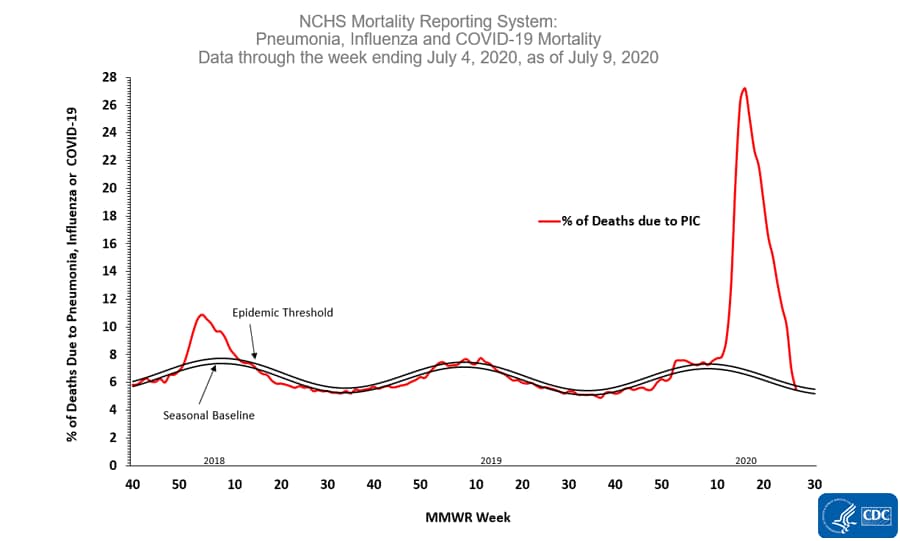My current COVID advice, and some good news
Back in March-April, the virus ran like wildfire through many congregate living facilities. Guidance on what to do, and the means for protecting staff and residents (training, masks and other PPE) were NOT provided to nursing homes. Emergency regulations issued by a number of states, including New York, which required nursing homes to take infectious COVID patients back from hospitals, virtually guaranteed new outbreaks.
Now that testing is widely available, of course we are finding many new cases, who are on average 15 years younger than before, and in general become much less ill.
I believe that the SARS-CoV-2 virus was created in a lab, using multiple techniques and genetic fragments that were already known and had been designed in multiple labs. If you are technically inclined, Yuri Deigin has written a beautiful summary of the evidence here. I have written about this on my blog, and discussed it during an interview with Dr. Joseph Mercola and in a Reddit AMA. “Gain of function” research, in which coronaviruses were created to give them added virulence, was government-approved in the US (and elsewhere) and performed in many laboratories that cooperated with each other, around the world, over the past 20 years. At least 4 US federal agencies (NIAID, NSF, USAID, DTRA) and many other governments, paid for this research. Neither I, nor others publicly investigating this area, understand why a number of countries collaborated to produce novel, highly virulent microorganisms. This is a question that has to be addressed, but not in this blog post.
Assuming SARS-CoV-2 was a lab creation, and first encountered lots of humans last fall, then it is likely that during its subsequent adaptations to the human species, it would develop less virulence. Or even disappear altogether.
We know that crude death rates (Covid deaths divided by known Covid case numbers) have been dropping dramatically worldwide since the onset of the pandemic. Partly this is due to improved care of patients, partly to identifying less severe infections due to increased availability of testing, possibly also due to false positives on testing. But my analysis of the number of patients currently hospitalized and current deaths, despite increased total cases, tells me the infection is just not making people as sick. Deaths rates are now less than 1/4 what they were at the peak of illness in the US.
Here are CDC’s stats on hospitalizations through July 18. Further down you will see their stats on deaths.
 Furthermore, we have learned that the vast majority of deaths in the United States are in the elderly. In Canada, 80% of deaths were said to occur in residents of nursing homes, and in Minnesota 80% as well. 90% of COVID deaths in Sweden were in those aged over 70, half of whom were in nursing homes. In the US, according to the CDC, 80% of COVID deaths have occurred in those over 65, and 92% of all deaths in those over 55.
Furthermore, we have learned that the vast majority of deaths in the United States are in the elderly. In Canada, 80% of deaths were said to occur in residents of nursing homes, and in Minnesota 80% as well. 90% of COVID deaths in Sweden were in those aged over 70, half of whom were in nursing homes. In the US, according to the CDC, 80% of COVID deaths have occurred in those over 65, and 92% of all deaths in those over 55. The NY Times wrote last week that 42% of all US COVID deaths were in nursing home residents, although data from all states is not available, so I do not consider this a reliable number. (For example, according to Kaiser Health News, “only 16 states report COVID-19 case and/or death data for assisted living facilities, either as a separate category (11 states) or combined with other long-term care facilities, other than nursing homes (5 states). Only 6 states report COVID-19 deaths occurring in assisted living facilities specifically.” Also see this WaPo article on how states do not uniformly report a variety of critical Covid indices.
This is unlike the 1918 flu epidemic, and yearly influenza, in which young people were more affected. While early in the pandemic we anticipated severe illness and deaths across the age range, that is not what we have seen:
Assumptions about the ways you get COVID have not changed since March. You get it from mucous membrane exposure (a droplet hitting your mouth, nose, eyes or a contaminated finger touching your face) or from indoor, airborne spread via inhaling the virus.
Airborne spread is defined differently than droplet spread, although there is really a continuum between the two. The language is very confusing. Droplets are defined as large exhaled particles that travel up to 3 to 6 feet, and then land on a surface, usually the ground, or possibly your shoe. Airborne particles are very small exhaled particles that may remain suspended in indoor air for hours or perhaps days. Many documented COVID clusters have been due to airborne spread, and in one notable example cases occurred throughout one floor of a large office building. Despite lots of data supporting airborne spread, some authorities have preferred to claim airborne spread was not a route of transmission.
The way you stop airborne spread of COVID is by diluting the viral particles in inhaled air, via improved ventilation, or by wearing effective masks, such as N95s, that are capable of keeping airborne particles out. You open windows, use fans to vent air outside, increase the number of air changes per hour. This will considerably reduce the risk from airborne spread. To construct a mask that provides good airborne protection, read this. Possibly UV or other methods applicable to indoor air inactivate coronaviruses, but it is not clear how well they work in practice.
In my opinion, masks are unnecessary outdoors, unless you are close enough to others that your face could be sprayed. I don’t use a mask unless I enter a building, and then I use the N95 I bought in a hardware store last February. Dr. Mercola has a good article on masks here.
I am skeptical about the 6 foot rule: it only prevents contamination via droplets, but masks already prevent droplet spread, at least according to the authorities. Neither stops airborne spread. I suspect that governments and the WHO have been loathe to acknowledge the existence of airborne spread because there are not many edicts they can issue to stop it, and because they have (still) failed to obtain adequate numbers of N95 masks for healthcare workers, let alone the rest of us. Two hundred thirty-nine scientists wrote to WHO this week, asking WHO to acknowledge airborne spread of coronaviruses.
Masks, however, also serve as a reminder that danger is omnipresent. While it is good to take precautions, the risk of death or disability from Covid, for most people, is small. Can we be more judicious about using them? I laugh when I see hikers wearing masks in the woods. Wearing them in elementary schools? Who’s kidding who?
UPDATE July 17: Based on death certificate data, the percentage of deaths attributed to pneumonia, influenza or COVID-19 (PIC) decreased from 8.1% during week 27 to 6.4% during week 28, representing the twelfth week of a declining percentage of deaths due to PIC.
That means that the number of weekly deaths from Covid and other causes of pneumonia has dropped from 27% of all deaths to 5.5%, less than the number of weekly deaths seen during an average flu season. There appear to be no more deaths in the US at this time of year than occurred in 2018 and 2019!


The bottom line is that we need to redo our COVID policies. The current situation is quite different than it was in March. While cases are rising, deaths are not rising congruent with new cases, the way they did in April. From OurWorldinData you can view a chart of cases vs deaths by day, since the start of the pandemic. Unfortunately, the graph would not post here.
The reason given for the lockdown was to stop the medical system from being overwhelmed. Luckily, apart from parts of NYC, it wasn’t, and the high Covid volume resolved in about a month. Where is the risk-benefit assessment for continuing lockdowns? While there are spots where the medical system is overloaded, such as near the Mexican border where people (American retirees?) have been reported to cross the border to be hospitalized in the US, hospitalizations, ICU admissions and deaths are way down overall. While deaths lag diagnoses by about 2 weeks, there was no spike in deaths after many thousands took part in demonstrations throughout the US, beginning in late May, over 6 weeks ago. While these facts don’t fit the predominant narrative, they are the facts.
‘Herd immunity’ for COVID should no longer be a dirty word. We must be close to achieving it in NYC, where COVID deaths peaked on April 7 at 600/day. There are currently under 20 COVID deaths/day in NYC. UPDATE: On July 13, NYC reported not a single COVID death in the past 24 hours! On July 15, NYC Covid deaths averaged under 10/day for the past week.
Due to emergency measures such as halting evictions for nonpayment, and providing $600/week unemployment benefits, often equalling 100% of lost income or more, the economic consequences of the lockdown have been postponed for millions of Americans. But they are getting ready to hit many more of us, hard.
UPDATE July 23: 2 well-known Oxford professors of epidemiology and evidence-based medicine (one the editor of the BMJ journal of evidence based medicine, the other a principal at the Cochrane Collaboration for decades) agree with me about reduced virulence of Covid-19, the low death rates despite large increases in cases, and the need to deal with the virus, rather than trying to hide from it. See this very informative interview.

Dr Nass, thank you for the most thought out, logical, and unbiased article that I have yet to read about Covid-19. Brilliant analysis!
Dr. Nass, my colleague, Dr. Matthews shared this excellent article. I appreciate your depth and insight as you present a logical perspective that many in our community need. Thank you for research to create this article.
Thank you so much for your posts on Covid-19. I find them among the best. I do not understand how the timestamp "Posted by Meryl Nass at 07/09/2020 at 1:30 AM" can be (highlight "1:30AM" to see the date). You have a sentence "On July 15, NYC Covid deaths averaged under 10/day for the past week." Was the blog piece updated with that July 15 information, or was the date, July 15 a numeric typo and the date should be before July 9? Thanks regardless though!
Hi Dr. Nass. Can you please double-check the new link to the interview you posted on July 23rd? It doesn't seem to be working and I would love to read. Thank you.